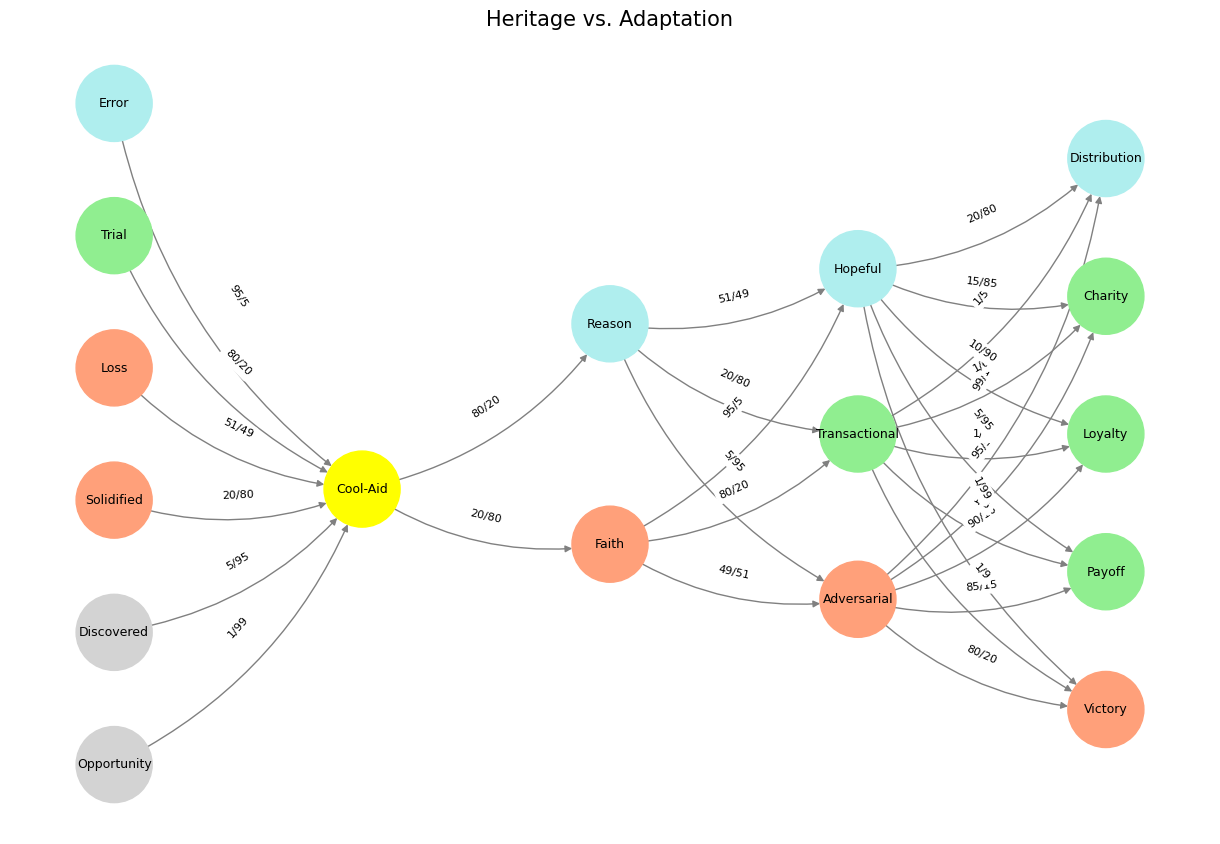Duality#
In the physical world, every gain is carved out through a relentless negotiation with loss. The laws of physics demand sacrifice; energy must be expended, risks must be taken, and failures must be endured before any meaningful progress is secured. The greatest innovations and societal advancements are etched into history through a trial-and-error process that rarely, if ever, offers shortcuts. Bridges collapse before stronger ones are built, civilizations rise from the ashes of failed empires, and the most profound discoveries emerge from long stretches of error-ridden inquiry. Whether in the laboratory, the battlefield, or the economic marketplace, opportunity is discovered in retrospect, not prophesied in advance.

Fig. 13 Trump vs. Jules. The juxtaposition of Donald Trump and Jules Winnfield from “Pulp Fiction” is as perplexing as it is intriguing. Jules, portrayed by Samuel L. Jackson, is a philosophical hitman who undergoes a profound transformation after a near-death experience, leading him to question his violent lifestyle and seek redemption. In contrast, Trump, a figure entrenched in the worlds of business and politics, often exhibits a brash and unyielding demeanor, seemingly impervious to introspection or change.#
Yet in the metaphysical realm, the story changes. Here, loss is often denied rather than confronted, and the human tendency toward optimism finds its fullest expression in the belief that paradise is always within reach—just one doctrine, one leader, or one system away. The metaphysical world has always been populated by those who, rather than learning through failure, absorb the words of soothsayers who promise a shortcut to salvation. Whether religious, ideological, or utopian in nature, these prophecies offer a vision where effort is minimized, struggle is bypassed, and milk and honey flow freely—not just for the deserving, but for all.
This dynamic is the engine of human history. The clash between the physical and the metaphysical has defined every great epoch, every revolution, and every disillusionment that followed. The French Revolution was ignited by the metaphysical promise of liberté, égalité, fraternité—a vision of universal justice and abundance—only to be swallowed by the guillotine’s cold, physical reality. The Bolsheviks sought to construct a worker’s paradise but found themselves grappling with the brutal mechanics of governance, scarcity, and human self-interest. Time and again, idealists build castles in the clouds only to watch them dissipate when the winds of reality blow too strong. The pattern is predictable: a grand metaphysical dream, a fervent march toward utopia, and the inevitable collision with the immutable laws of human nature and material limitation.
This is not to say that the metaphysical has no role; quite the opposite. Without the dream, there is no movement. Without the illusion, there is no striving. The dialectic between physical constraint and metaphysical ambition is what drives civilization forward. The trick is recognizing the difference between faith as fuel and faith as delusion—between using ideals as a guiding light and mistaking them for a foregone conclusion. The wise do not reject dreams of paradise outright; they simply understand that paradise, if it ever comes, will be built brick by brick, through sacrifice and toil, rather than granted by decree.
Thus, human history in a nutshell is a pendulum swing between two forces: those who learn from failure and those who refuse to acknowledge it. The builders and the dreamers, the empiricists and the prophets, the pragmatists and the utopians. Each generation rediscovers the same truth—that milk and honey do not flow for all, and that paradise, when promised too easily, is almost certainly a mirage.
Show code cell source
import numpy as np
import matplotlib.pyplot as plt
import networkx as nx
# Define the neural network layers
def define_layers():
return {
'Suis': ['Opportunity', 'Discovered', 'Solidified', 'Loss', "Trial", 'Error'], # Static
'Voir': ['Cool-Aid'],
'Choisis': ['Faith', 'Reason'],
'Deviens': ['Adversarial', 'Transactional', 'Hopeful'],
"M'èléve": ['Victory', 'Payoff', 'Loyalty', 'Charity', 'Distribution']
}
# Assign colors to nodes
def assign_colors():
color_map = {
'yellow': ['Cool-Aid'],
'paleturquoise': ['Error', 'Reason', 'Hopeful', 'Distribution'],
'lightgreen': ["Trial", 'Transactional', 'Payoff', 'Charity', 'Loyalty'],
'lightsalmon': ['Solidified', 'Loss', 'Faith', 'Adversarial', 'Victory'],
}
return {node: color for color, nodes in color_map.items() for node in nodes}
# Define edge weights (hardcoded for editing)
def define_edges():
return {
('Opportunity', 'Cool-Aid'): '1/99',
('Discovered', 'Cool-Aid'): '5/95',
('Solidified', 'Cool-Aid'): '20/80',
('Loss', 'Cool-Aid'): '51/49',
("Trial", 'Cool-Aid'): '80/20',
('Error', 'Cool-Aid'): '95/5',
('Cool-Aid', 'Faith'): '20/80',
('Cool-Aid', 'Reason'): '80/20',
('Faith', 'Adversarial'): '49/51',
('Faith', 'Transactional'): '80/20',
('Faith', 'Hopeful'): '95/5',
('Reason', 'Adversarial'): '5/95',
('Reason', 'Transactional'): '20/80',
('Reason', 'Hopeful'): '51/49',
('Adversarial', 'Victory'): '80/20',
('Adversarial', 'Payoff'): '85/15',
('Adversarial', 'Loyalty'): '90/10',
('Adversarial', 'Charity'): '95/5',
('Adversarial', 'Distribution'): '99/1',
('Transactional', 'Victory'): '1/9',
('Transactional', 'Payoff'): '1/8',
('Transactional', 'Loyalty'): '1/7',
('Transactional', 'Charity'): '1/6',
('Transactional', 'Distribution'): '1/5',
('Hopeful', 'Victory'): '1/99',
('Hopeful', 'Payoff'): '5/95',
('Hopeful', 'Loyalty'): '10/90',
('Hopeful', 'Charity'): '15/85',
('Hopeful', 'Distribution'): '20/80'
}
# Calculate positions for nodes
def calculate_positions(layer, x_offset):
y_positions = np.linspace(-len(layer) / 2, len(layer) / 2, len(layer))
return [(x_offset, y) for y in y_positions]
# Create and visualize the neural network graph
def visualize_nn():
layers = define_layers()
colors = assign_colors()
edges = define_edges()
G = nx.DiGraph()
pos = {}
node_colors = []
# Add nodes and assign positions
for i, (layer_name, nodes) in enumerate(layers.items()):
positions = calculate_positions(nodes, x_offset=i * 2)
for node, position in zip(nodes, positions):
G.add_node(node, layer=layer_name)
pos[node] = position
node_colors.append(colors.get(node, 'lightgray'))
# Add edges with weights
for (source, target), weight in edges.items():
if source in G.nodes and target in G.nodes:
G.add_edge(source, target, weight=weight)
# Draw the graph
plt.figure(figsize=(12, 8))
edges_labels = {(u, v): d["weight"] for u, v, d in G.edges(data=True)}
nx.draw(
G, pos, with_labels=True, node_color=node_colors, edge_color='gray',
node_size=3000, font_size=9, connectionstyle="arc3,rad=0.2"
)
nx.draw_networkx_edge_labels(G, pos, edge_labels=edges_labels, font_size=8)
plt.title("Heritage vs. Adaptation", fontsize=15)
plt.show()
# Run the visualization
visualize_nn()


Fig. 14 It’s a known fact in the physical world that opportunity is discovered and solidified through loss, trial, and error. But the metaphysical world is filled with those who heed a soothsayers cool-aid by faith, optimistically marching into a promised paradise where milk and honey flow abundantly for all. This is human history in a nutshell#

